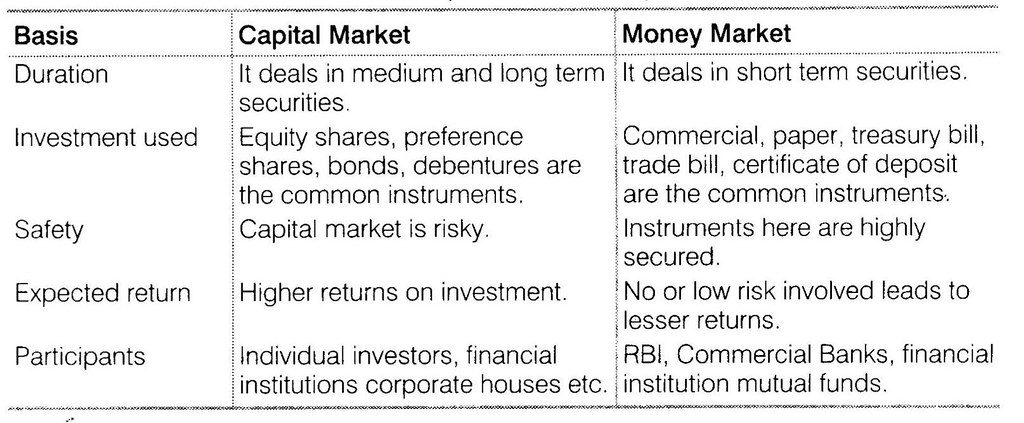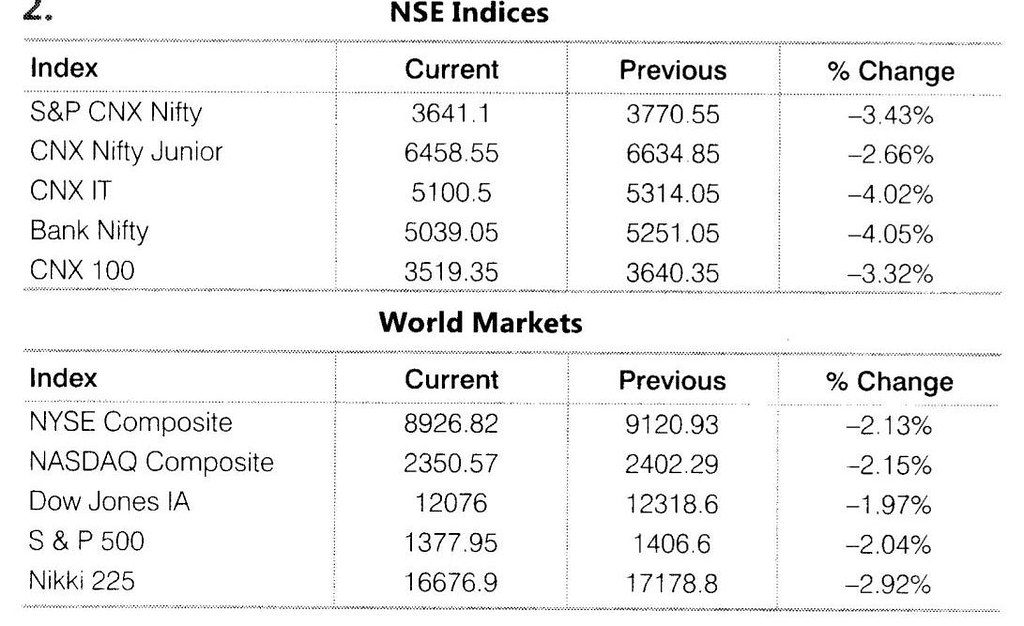Short Answer Type Questions
1. What are the functions of a Financial Market?
Ans: Financial market plays an important role in the allocation of scarce resources in an economy by performing the following four important functions
(i) Mobilisation of Savings and Channelising Them into the Most Productive Uses
A financial market facilitates the transfer of savings from savers to investors. It gives choice to the saver of different investments and thus, it helps to channelise surplus funds into the most productive use.
(ii) Facilitate Price Discovery
In a financial market, the households are suppliers of funds and business firms represent the demand. The interaction between them helps to establish a price for the financial asset which is being traded in that particular market.
(iii) Provide Liquidity to Financial Assets
Financial markets facilitate easy purchase and sale of financial assets. Flolders of assets can readily sell their financial assets through the mechanism of financial market.
(iv) Reduce the Cost of Transactions
Financial markets provide valuable information about securities being traded in the market. It helps to save time, effort and money that both buyers and sellers of a financial asset would have to spend to try or otherwise find each other.
2. “Money Market is essentially a Market for short term funds.” Discuss.
Ans: The money market is a market for short term funds which deals in monetary assets whose period of maturity is upto one year. These assets are close substitutes for money. It is a market where low risk, unsecured and short term debt instruments that are highly liquid are issued and actively traded everyday. It enables the raising of short term funds for earning returns. The major participants in the market are the Reserve Bank of India, Commercial Bank, Non-Banking Finance Companies, State Governments, Large Corporate Houses and Mutual Funds.
3. What is a Treasury Bill?
Ans: A treasury bill is an instrument of short term borrowing by the Government of India Maturing in less than one year. They are also known as Zero Coupon Bonds issued by the RBI on behalf of the Central Government to meet its short term requirement of funds. ‘Treasury bills are issued in the form of a promissory note. They are highly liquid and have assured yield and negligible risk of default. They are issued at a price which is lower than their face value and repaid at par treasury bills are available for a minimum amount of Rs. 25,000.
4. Distinguish between Capital Market and Money Market.
Ans: Difference between Capital and Money Market
5. What are the functions of a Stock Exchange?
Ans: The efficient functioning of a stock exchange creates a conducive climate for an active and growing primary market following are the important functions of a stock exchange
(i) Providing Liquidity and Marketability to Existing Securities
The basic function of a stock exchange is the creation of a continuous market where securities are bought and sold. It gives investors the chance to disinvest and reinvest. This provides both liquidity and easy marketability to the existing securities in the market.
(ii) Pricing of Securities
Share prices on a stock exchange are determined by the forces of demand and supply. A stock exchange is a mechanism of constant valuation through which the prices of securities are determined. Such a valuation provides important instant information to both buyers and sellers in the market.
(iii) Safety of Transactions
The membership of a stock exchange is well-regulated and its dealings are well defined according to the existing legal framework which ensures that the investing public gets a safe and fair deal on the market.
(iv) Contributes to Economic Growth
A stock exchange is a market in which existing securities are resold or traded. This process of disinvestment and reinvestment saving get channelised into productive investment avenues. This leads to capital formation and economic growth.
(v) Spreading of Equity Cult
The stock exchange plays vital role in ensuring wider share ownership by regulating new issues, better trading practices and taking effective steps in educating the public about investments.
(vi) Providing Scope for Speculation
The stock exchange provides sufficient scope within the provisions of law for speculative activity in a restricted and controlled manner.
6. What are the objectives of the SEBI?
Ans: The overall objective of SEBI is to protect the interest of investors, promote the development and regulate the securities in market. This may be elaborated as follows
(i) To regulate stock exchanges and the securities industry to promote their orderly functioning.
(ii) To protect the rights and interests of investors, particularly individual investors to guide and educate them.
(iii) To prevent trading malpractices and achieve a balance between self-regulation by the securities and its statutory regulation.
(iv) To regulate and develop a code of conduct and fair practices by intermediaries like brokers, merchant bankers etc with a view to making them competitive and professional.
7. State the objectives of the NSE.
Ans: NSE was setup with the following objectives
(i) Establishing a nationwide trading facility for all types of securities.
(ii) Through an appropriate communication network, ensuring equal access to investors.
(iii) Through electronic trading system, provides a fair, efficient and transparents security market.
(iv) It enables shorter settlement cycles and book entry settlements.
(v) Meeting international benchmarks and standards.
8. What is the OTCEI?
Ans: The OTCEI is a company incorporated under the Companies Act, 1956. It was set up to provide small and medium companies an access to the capital market for raising finance in a cost effective manner. It is fully computerised, transparent, single window exchange which commenced trading in 1992. This exchange is established on the lines of NASDAG the OTC exchange in USA. If has been promoted by UTI, ICICI, IDBI, IFCI, LIC, GIC, SBI capital markets and can bank financial services.
It is a negotiated market place that exists any where as opposed to the auction market place, represented by the activity on securities exchange. Thus, in the OTC exchange, trading takes place when a buyer or seller walks up to an OTCEI counter, taps on the computer screen, finds quotes and effects a purchase or sale depending on whether the prices meet their target.
Long Answer Type Questions
1. Explain the various money Market Instruments.
Ans: Money Market Instruments
(i) Treasury Bill
A treasury bill is an instrument of short term borrowing by the Government of India maturing in less than one year. They are also known as Zero Coupon Bonds issued by Reserve Bank of India on behalf of the Central Government to meet its short term requirements of funds. They are issued in the form of a promissory note. They are highly liquid and issued at a price which is lower than their face value and repaid at par. Treasury bills are available for a minimum amount of Rs.25,000.
(ii) Commercial Paper
Commercial paper is a short term unsecured promissory note, negotiable and transferable by endorsement and delivery with a fixed maturity period. It is issued by large and creditworthy companies to raise short term funds at lower rates of interest than market rates. It usually has a maturity period of 15 days
to one year. The issuance of commercial paper is an alternative to bank borrowing for large companies that are generally considered to be finally strong. It is sold at discount and redeemed at par.
(iii) Call Money
Call money is a short term finance repayable on demand, with a maturity period of one day to fifteen days, used for inter-bank transactions. Commercial Banks have to maintain a minimum cash balance known as cash reserve ratio. Call money is a method by which banks borrow from each other.
(iv) Certificate of Deposit
Certificates of deposit are unsecured, negotiable, short term instruments in bearer form, issued by Commercial Banks and development financial institutions. They can be issued to individuals, corporations and companies during periods of tight liquidity when the deposit growth of banks is slow but the demand for credit is high. They help to mobilise a large amount of money for short periods.
(v) A Commercial Bill
A commercial bill is a bill of exchange used to finance the working capital requirements of business firms. It is a short term negotiable, self-liquidating instrument which is used to finance the credit sales of firms, when goods are sold on credit, the buyer becomes liable to make payment on a specific date in future.
2. What are the methods of floatation in Primary Market?
Ans: The primary market is also known as the new issues market. It deals with new securities being issued for the first time. There are various methods of floating new issues in the primary market
(i) Offer Through Prospectus
This involves inviting subscription from the public through issue of prospectus. A prospectus makes a direct appeal to investors to raise capital, through an advertisement in newspapers and magazines. The issues may be under written and also required to be listed on at least one stock exchange. The contents of the prospectus have to be in accordance with the provisions of the Companies Act and SEBI disclosure and investor protection guidelines.
(ii) Offer for Sale
Under this method securities are not issued directly to the public but offered for sale through intermediaries like issuing houses or stock brokers. In this case, company sells securities enblock at an agreed price to brokers who, in turn, resell them to the investing public.
(iii) Private Placement
Private placement is the allotment of securities by a company to institutional investors and some selected individuals. It helps to raise capital more quickly than a public issue. Access to the primary market can be expensive on account of various mandatory and non-mandatory expenses.
(iv) Rights Issue
This is a privilege given to existing shareholders to subscribe to a new issue of shares according to the terms and conditions of the company. The shareholder are offered the ‘right’ to buy new shares in proportion to the number of shares they already possess.
(v) e-IPOs
A company proposing to issue capital to the public through the on-line system of the stock exchange has to enter into an agreement with the stock exchange. This is called an Initial Public Offer (IPO). SEBI registered broker’s have to be appointed for the purpose of accepting applications and placing orders with the company the issuer company should appoint a registrar to the issue having electronic connectivity with the exchange. The issuer company can apply for listing of its securities on any exchange other than the exchange through which it has offered its securities. The lead manager co-ordinates all the activities amongst intermediaries connected with the issue.
3. Explain the Capital Market reforms in India.
Ans: The National Stock Exchange is the latest, most modern and technology driven exchange. NSE has setup a nationwide fully automated screen based trading system. The NSE was setup by leading financial institutions, banks, insurance companies and others financial intermediaries. It is managed by professionals, who do not directly or indirectly trade on the exchange. The trading rights are with the trading members who offer their services to the investors. The Board of NSE comprises senior executives from promoter institutions and eminent professionals, without having any representation from trading members.
Objectives of NSE
(i) Establishing a nationwide trading facility for all types of securities.
(ii) Ensuring equal access to investors all over the country through an appropriate communication network.
(iii) Providing a fair, efficient and transparent securities market using electronic trading system.
(iv) Enabling shorter settlement cycles and book entry settlements.
(v) Meeting international bench marks and standards..
Within a span of 10 year, NST was able to achieve its objectives for which it was set up. It has been playing a leading role as a change agent in transforming the Indian capital market.
4. Explain the objectives and functions of SEBI.
Ans: Objectives of SEBI
Functions of SEBI
Keeping in mind the emerging nature of the securities market in India, SEBI was entrusted with the twin task of both regulation and development of the securities market. It has certain functions
Regulatory Functions
(i) Registration of brokers and sub-brokers and other players in the market.
(ii) Registration of collective investment schemes and mutual funds.
(iii) Regulation of stock brokers, portfolio exchanges, underwriters and merchant bankers and the business in stock exchanges and any other securities market.
(iv) Regulation of takenover bids by companies.
(v) Calling for information by undertaking inspection conducting enquiries and audits of stock exchanges and intermediaries.
(vi) Levying for or other charges for carrying out the purposes of the act.
(vii) Performing and exercising such power under Securities Contracts Act, 1956, as may be delegated by the Government of India.
Development Functions
(i) Training of intermediaries of the securities market.
(ii) Conducting research and publishing information useful to all market segments.
(iii) Undertaking measures to develop the capital markets by adopting a flexible approach.
Protective Functions
(i) Prohibition of fraudulent and unfair trade practice like making misleading statements, manipulations, price rigging etc.
(ii) Controlling insider trading and imposing penalties for such practices.
(iii) Undertaking steps for investor protection.
(iv) Promotion of fair practices and code of conduct in securities market
5. Explain the various segments of NSE.
Ans: NSE provides trading in the following two segments
(i) Whole Sale Debt Market Segment This segment provides a trading platform for a wide range of fixed income securities that include central government securities, treasury bills, state development loans, bonds issued by public sector undertakings, floating rate bonds, zero coupon bonds, index bonds, commercial paper, certificate of deposit, corporate debentures and mutual funds.
(ii) Capital Market Segment The capital market segment of NSE provides efficient and transparent platform for trading in equity, preference, debentures, exchange traded funds as well as retail government securities.
Case Problems
1. ‘R’ Limited is a real estate company which was formed in 1950. In about 56 years of its existence the company has managed to carve out a niche for itself in this sector. Lately, this sector is witnessing a boom due to the fact, that the Indian economy is on the rise. The incomes of middle class are rising. More people can afford to buy homes for themselves due lo easy availability of loans and accompanying tax concessions.
To expand its business in India and abroad the company is weight various options to raise money through equity offerings in India. Whether to tap equity or debt, market whether to raise money from domestic market or international market or combination of both? When their to raise the necessary finance from money market or capital market. It is also planning to list itself in New York Stock Exchange to raise money through ADR’s. To make its offerings attractive it is planning to offer host of financial plans products to its stakeholders and investors and also expand it’s listing at NSE after complying with the regulations of SEBI.
1. What benefits will the company derive from listing at NSE?
Ans: Following are the benefits the company can derive from listing at NSE
(i) NSE provides nationwide trading facility for all types of facilities.
(ii) The liquidity and best available prices for the securities are ensured by the processing speed of the exchange.
(iii) The NSE network is used to disseminate information and company announcements across the country.
(iv) Enabling shorter settlement cycles and book entry settlement.
2. What are the regulations of SEBI that the company must comply with?
Ans: Following are the regulations of the SEBI for new issue that the company must comply with
(i) Prospectus has to be attached with every application.
(ii) Objective of the issue and cost of project should be mentioned in the prospectus.
(iii) Company’s management, past history and present business of the firm should be highlighted in the prospectus.
(iv) Subscription list for public issue should be kept open for a minimum of 3 days and maximum of 10 days.
(v) Collections agents are not allowed to collect application money in cash.
(vi) Issue should make adequate disclosure regarding the terms and conditions of redemption, security conversion and other relevant features of the new instrument so that an investor can make reasonable determination of risks, returns, safety and liquidity of the instrument. The disclore shall be vetted by SEBI in this regard.
3. How does the SEBI exercise control over ‘R’ Limited in the interest of investors?
Ans: SEBI will exercise control over ‘FT limited by
(i) Prohibiting fraudulent and unfair trade practices in the securities market unfair trade practices include price rigging, making misleading statements.
(ii) Prohibiting insider trading i.e., restricts the persons having access to price sensitive information about the company to take undue advantage of it.
(iii) Examing that adequate disclosure about the terms and conditions of redemption, security conversion and other relevant features of the new instrument at the time of issue is made so that an investor can make reasonable determination of risks, returns, safety and liquidity of the instrument
1. What do you mean by a stock index? How is it calculated?
Ans: Stock index refers to the index used to capture the movement of the stock market. It is a barometer which measures overall market trend through a set of stocks which are representatives of the market. An ideal index must represent changes in the prices of securities and also show the price movement of different classes of shares. Most of the stock market uses the following 3 methods of calculating index.
(i) Price Weighted Index An index reflecting the sum of the prices of the sample share in a certain year/month/week/day with reference to a base year.
(ii) Equal Weighted Index An index reflecting the simple arithmetic average of the price relatives of a sample of shares in a certain period with reference to base year.
(iii) Value Weighted Index It is an index reflecting the aggregate market capitalisation of the sample shares in certain period in relation to base year.
2. What conclusions can you draw from the various movements of NSE stock indices?
Ans: There is a downward swing in the stock market. While comparing the previous and current index of NSE we can say that there is a depression in the market as index is down for all the sectors.
3. What factors affect the movement of stock indices? Elaborate on the nature of these factors.
Ans: The fall in the domestic market, as given in the above table, can significantly be attributed to the market sentiments of world market. We can see the world indices and NSE indices are moving in the same direction.
4. What relationship do you see between the movement of indices in world markets and NSE indices?
Ans: There is direct relation between NSE indices and world market indices. As there is negative trend in world index, it brings negative trend in NSE index also.
5. Give details of all the indices mentioned above, you can find information on the web or business magazines.
Ans: Answer to this question is based on reader’s evaluation.
The above figures are taken from the website of National Stock Exchange of India. They illustrate the movement of NSE stock indices as well as world stock indices on the date indicated.





